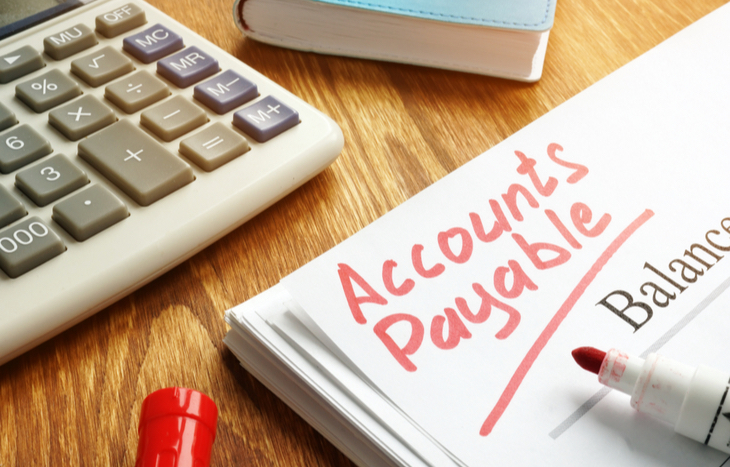What is Accounts Payable (AP)?
When evaluating a company’s current financials, accounts payable is an important figure to consider. What is accounts payable (AP)? It’s a summary of current debts owed to vendors and suppliers. Depending on how you look at it, AP represents upcoming due, a short-term loan and/or obligations to partners. Regardless of perspective, it’s easily summed up in one word: liabilities. This is what a business owes.
Accounts payable factors heavily into cash flow, since it represents the outflow of funds. As such, its advantageous for companies to prolong this outflow. This is often a double-edged sword: companies have more cash on-hand now, but a higher collection of dues in the future.
Here’s a look at the balancing act that comes with AP management and how it breaks down as part of a company’s financial health.

Current Liabilities
On the balance sheet, accounts payable shows up under “current liabilities.” In accrual basis accounting, the transaction records at origination—even if funds haven’t changed hands. That means the company owes a debt until the transaction executes.
For example, if ABC Company places an order for 1,000 widgets from a supplier at a cost of $1 per widget, they’ll owe the company $1,000. However, most suppliers offer net terms, which means the company doesn’t need to pay for those goods for a certain number of days. In the meantime, ABC Company receives its widgets and begins selling them. If the order is on NET 15, the company doesn’t need to pay its bill for 15 days. The balance sheet will reflect 1,000 widgets currently in inventory (and their value), with an equal cost in the accounts payable section, representing the liability.
This situation is commonplace for nearly every business. The idea is that net terms give a company enough time to generate revenue, to pay back suppliers and make a profit. This is the concept of cash flow, with AP representing debts owed before calculating bottom-line profit.
Net Terms at a Glance
Net terms are the lynchpin for controlling cash flow. Companies can’t always predict when goods and services will sell, which means they need to focus on creating a buffer between incoming revenue and outgoing payments. Net terms accomplish this.
Net terms typically run on 15-, 30-, 45- or 60-day terms. This is the number of days between invoice and payment due date. The longer the net terms, the more time a company has to pay its debts. This is why many companies value net terms so heavily: it’s essentially an interest-free loan for the duration of the term.
Net terms can change from vendor to vendor, or even month-to-month. Companies can often leverage their relationship into better terms or even demand better terms based on order frequency or volume.
Monitoring Accounts Payable Trends
Accounts payable provides strong insight into a company’s ability to manage operations and pay its debts. Moreover, it gives insight into company growth or its operational costs from period to period.
For example, a quarterly increase in accounts payable means the company is relying more on credit to pay vendors. A reduction means it’s paying in cash or paying quicker than net terms indicate. Investors who know how to read a balance sheet will dissect it to uncover these trends, and to learn more about how they compare to the rest of the balance sheet.
It’s important to note that accounts payable is subject to manipulation, to a degree. For instance, a company can quickly pay down its debts with cash on-hand before an accounting period, to show few-to-no liabilities for the current period. This is why comparing accounts payable trends over time is important.
Accounts Payable vs. Accounts Receivable
Did you know accounts payable and accounts receivable are direct opposites? While accounts payable represents cash outflows, accounts receivable represents cash inflows. For businesses, operations involve balancing the two. Companies accrue liabilities (payable) to run their business, while revenue (receivable) is the demand for the product or services it sells. As a company establishes itself and grows, so will accounts payable and receivable.
The goal is always to ensure receivables outweigh payables—or that net terms benefit the business’ ability to control cash flow.
Accounts Payable are Not Expenses
A common misconception about accounts payable are that they represent operational expenses. This is not the case. Accrued expenses show up on the company’s income statement and are not considered liabilities. Accounts payable are specific to liabilities owed to another company or individual through credit. Moreover, expenses are already paid and recorded as such. The simplest way to make a distinction between them is to remember that accounts payable have invoices; expenses do not.
AP Offers Insights into Operations
Accounts payable is a good representation of a company’s owed debts. While it hasn’t actually realized these debts yet, they’re upcoming and will become expenses depending on the net terms associated with them. The company has already received the benefit of goods or services—now, it needs to pay for them.
To learn more about how financial reports can affect your investments, sign up for the Profit Trends e-letter below. The team at Profit Trends provide daily analysis that can help you discover upcoming stock trends.
Investors looking at a company’s AP can learn a lot about how it uses credit and what its cash flow is like. Companies with large liabilities and poor accounts receivable don’t signal healthy cash flow. Meanwhile, companies with good income and consistent accounts payable activity represent responsible, cash flow positive businesses. It’s important not to look at accounts payable in a vacuum—rather, as part of the broader balance sheet.





